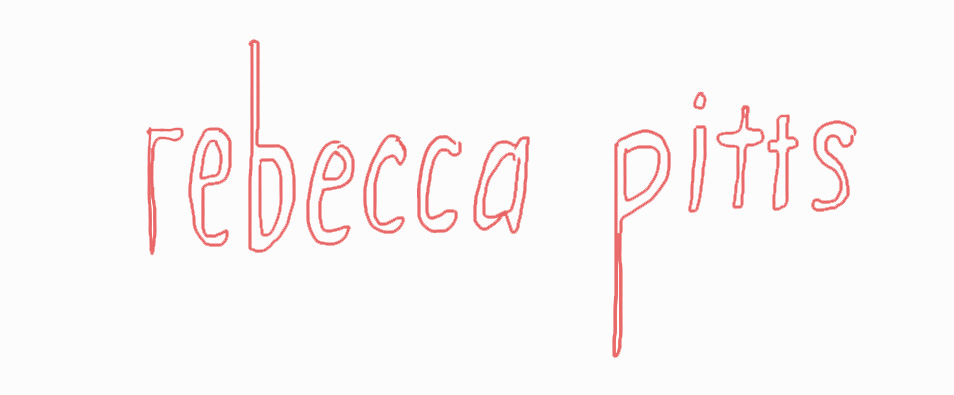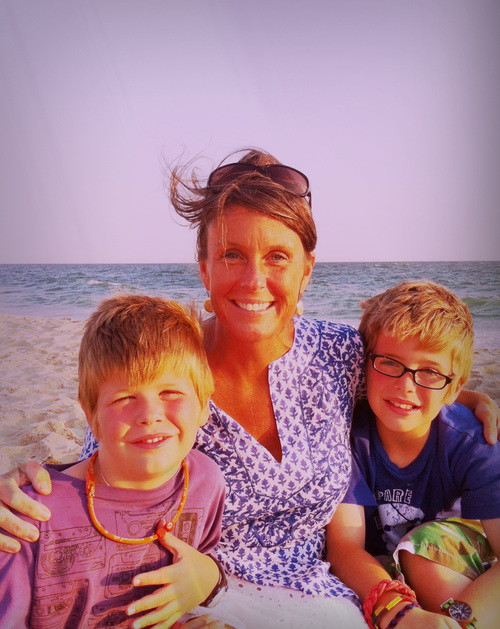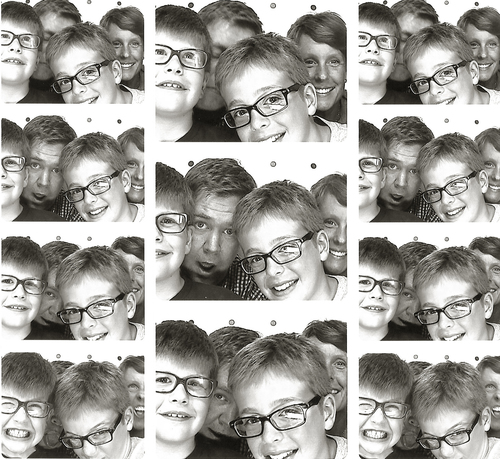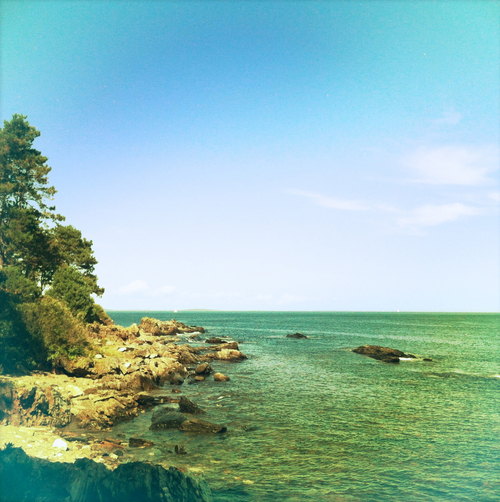I am so thrilled to feature Jenny Prinn, a talented and prolific artist who lives and works in Maine and recently re-burst onto the arts scene. She's also a wife to a fellow artist, a mother of two boys (ages 9 and 10) and—yes, there's an and!—an occasional professional photo-stylist.
Today we're chatting about everything from the Maine summers and winters that influence her gorgeous, vibrant color palette, her re-entry into creative work (and how that break from painting has made her more in touch with her authentic creative self), and her partnership with the luxury brand Serena & Lily.
Whether you're just starting out in a creative endeavor or you have years under your belt, I think you'll get so much out of this interview. With a wisdom beyond her years, Jenny's jumping in every day and riding that youthful joy and enthusiasm for her craft—something that all of us can aspire to!
OK, let's start at the beginning. Tell me about your background and education.
I was raised by two antique dealers. From toddlerhood I was raised around amazing art, american furniture, decorative items and jewelry. My dad was what you called a picker back before the show "American Pickers" became popular and anyone even knew what a picker was. He would knock on people's doors and introduce himself and say "I'm looking for rugs or art," or whatever he happened to be searching for at the time. They would let him into their homes and he would go through their stuff, stem to stern, attic to basement, buy things from them and then would usually sell it to another dealer before it would end up in a shop. In the 70's, he was on the forefront of that. And Maine had a lot of untapped merchandise in homes at that time.
As a kid, the breadth of information that I learned and my appreciation for so many different periods and styles and mediums and forms was constant—both my parents were dealers so it was part of our life. The stuff came in off of his suburban. At night they processed it, they researched it, they priced it, and they talked about it. And I just learned by osmosis. I would say that's sort of the genesis of my appreciation of art and beauty and design and history, too, in terms of objects.
I was always interested in art. I always took classes on the weekends during high school at Portland College of Art (it's now called Maine College of Art). I was always pursuing something artistic. Then I ended up going to Mt. Holyoke college, an all-women's college. I started as a double major in Art History and Studio Art.
Along the way, things changed. I think it was a combination of a lot of things—and I definitely think that the fear of exposing myself—in the way that being an artist requires—was part of that. I took a little time off from school and took classes in Maine at Bates and worked a little bit. When I returned to Mt. Holyoke, I really was just looking to be able to matriculate so I dropped Studio Art as part of my major. (To major in Art required a lot of time—and a lot of my soul—and I just wasn't ready to give either one.) At that point I just wanted to be able to forge through and be done. So I dropped the Studio Art and I picked up Anthropology which I absolutely loved. So I graduated from Mt. Holyoke with a degree in Art History and Anthropology.
Wow! I have to stop you to tell you those were my two degrees in college.
You're kidding me! That's so great! I did take a lot of art classes in college but once I returned I focused more on traditional academics. Art History is another love of mine. It fits right into the way I was raised, as a child of antique dealers and my appreciation for that world. So, to make a very long story short, I would have to say that I'm pretty much self-taught. From that point on, I took the reins myself and had pockets of exploration and periods of not really doing anything. After college, I took some classes at Maine College of Art in different areas that interested me. The oldest of my boys was two years and the youngest just six months when I last took a class—now they are ten and soon to be nine. That was 8 years ago!
What made you decide to return to art after your schooling?
I had a pin-pointed impetus. My dad became terminally ill in 2001. He was diagnosed just before 9/11 happened. We didn't know how much time he would have and I was extremely close to him. I'm also a photo-stylist and have been styling for about 20 years or so. At that time, I had an agent in Boston, I traveled a lot, and I was married but it was before we had children. We had also just purchased a 140-year old farmhouse that we were renovating ourselves. And then my dad got sick. I had sort of wanted to get off the styling road anyway and this was the push for me to do that. So I left my agency and decided that I would just represent myself at that point and work locally. And I revisited painting, specifically. I had dabbled in it in my twenties, but when my dad got sick, I felt the need to be able to have an outlet. That was 2001, and I started painting prolifically. It wouldn't stop. It was just there. It was an overflowing fountain and not that the work was all great (because it wasn't!) but it was me working through how the medium works for me. I actually started selling online at that point, but bear in mind "online" in those days was really still in its infancy and not like it is today! There weren't any avenues for big exposure.
I did though, have tremendous success right away. It was pretty amazing and shocking and I was sort of floored by it all and fueled by it all. But, in retrospect, I hadn't found my voice through the paintbrush. I was still in a young, experimental phase. But something was resonating with people out there. They were buying it. I did it for a couple of years, and then I got pregnant with my first child. I had a difficult pregnancy and he was born 5 1/2 weeks early. He was fine, but painting really took a back seat at that point. My dad continued to be ill and I got pregnant with my second child when my first one was 8 months old. My mom became sick at that time as well and life just had a different path for me. I gladly put my art in the backseat and put everything into motherhood and caring for my parents and charged through. I enjoyed every minute of it—but I did feel the urges and the itch to get back to my art. During this time we moved to a new home and I didn't have a studio space. So it meant that I had to paint at the kitchen table. It was so much work to bring everything out on to the kitchen table and clean it up before going to bed so my toddlers wouldn't be in it in the morning. So it didn't happen.
What made you finally get back into your work?
About 2 years ago, I really was feeling the need to start again. And it was strong. It was almost like it was in 2001 in terms of needing an outlet and a voice. I hauled everything out at night and painted on the kitchen table and put it all away at two in the morning. But I had to paint small because I didn't have the space. I like to paint small but I like to paint small when I choose to paint small. Not because I have to. I was feeling stifled. Finally we decided to renovate our basement and make that a studio. We put in a sink and a storage space off of the studio to keep me organized. I just wanted to be able to create, and walk away from it late at night if I need to and not have to put everything away. I finally just pulled myself up from the bootstraps and said OK. You're going to do this. You're going to start again. I started and within a few months I was with Serena & Lily. I have been with them for a little over a year.
That's amazing. It happened so fast for you! Can you tell me more about working with them?
Yes, it did happen very quickly! I feel so blessed and fortunate! My artwork is available on their website, in their new Design Shop in San Francisco, and their Beach Market in the Hamptons. It's been such an amazing experience working with them and I just love that the company was started by and is run by two women! Both are moms who are managing to make it all work—they're also juggling it all. The beginning of their story is remarkably similar to the rest of us women, moms, and creatives that have decided to make the leap!
That's really encouraging. Are there other ways you're making money as an artist? Where else do you sell your work?
I launched my own site in the early part of this year because people were trying to find me and I didn't have a site. I try to spend some time painting things for my site so things don't stay too static there. I also have work available at Maison Luxe, a beautiful high end interiors store in Seattle. And, I do commission work and figure those schedules into everything else.
Do you struggle with work-life balance as a full-time artist and a mom?
JENNY: I'm still struggling with balancing everything. I'm still photo-styling a little bit here locally. And I'm painting as much as I possibly can and I'm raising two boys whose schedules are getting so much busier. I'm trying to keep a clean house. I would love to have more outlets for selling my work but it's all happened so fast for me that this is fitting well right now. I'm sort of playing catch up; I'm changing my life to fit this.
I've never been happier in my life, but I've never been more exhausted in my life or more overwhelmed, in a good way. Those words tend to have negative connotations but it is amazing and wonderful and I wake up every day in disbelief that this is all happening for me. But I'm exhausted. I stay up until two or three o'clock in the morning but it's all worth it. I wouldn't trade it for anything and I love it.
That's the dream, I think! What is your process for inspiration and research?
There was a big shift that happened when I picked up painting again about a year and a half ago (different from when I was painting over a decade ago). I'm a lot older in terms of years and with that, I'm more sure of who I am as a woman and a mother, a daughter, and in my place in the world. I always knew that when I was painting over ten years ago I wasn't being totally true to myself. I was experimenting and exploring and learning to understand the medium but I felt as though I was painting what people expected a painting to be instead of really listening to my core. It was still resonating with people, which was great, but I always felt—would they like what I really want to paint? Would they buy what I really want to paint? That was always nagging at me.
When I started painting again, I decided to hit the ground running by painting exactly what I wanted to paint. It was hard and scary but it was a 40-something year old decision. It was a conversation with myself: You have one chance at this. You just have to do this. You have to put yourself out there and see if there's a response. In my early 30s, I felt that art was supposed to be serious and deeply intellectual. It had to be heavy. And it's so not me and I struggled with that. This time, I listened to my soul. As soon as I started to listen and see and feel and experience what was happening around me, I realized it was all of the little things of the everyday experience that made my heart sing. These tiny snapshots of beautiful moments—they might be nanoseconds or hours. When I feel this, I try to art journal or sketch on the back of a receipt or piece of scrap paper. I try to quickly jot down compositions or juxtapositions or color combinations. I use these sketches to explore an idea and I tend to work in series—I try to change it, push it, play with it and see where it's taking me. I usually hit a wall with it, so I'll leave it alone. And then I'll come back to it to explore it.
As you're talking about your process, I'm looking at your work and thinking about how living near the ocean in Maine informs your process and art.
Our town is a little coastal town from the 1700's and was a little clipper ship building community. We had a boat growing up and summered on an island in Casco Bay. It's an important thing for me. It influences me in terms of color palettes. The ocean is very different in the winter and summer. I can see the cycle of the seasons and how it affects my work. Summer—even the hint of summer—means an explosion of true blues. The Atlantic Ocean, crisp, New England blues. It's salty, it's the sunlight dancing off the surface. It's all of those things. Because the summer in Maine is so short, we appreciate it so much here. Childhood summers and now summers being created for my children come into play in my work as well—inflatable rafts, colors of popsicles, driving in the car in summer traffic, road maps and road signs, eating outdoors, all of the things that process as summer in my brain.
The winter is special for me, too—I love when it's time to come indoors. I relish the time of year when the clocks get turned back. We turn inward. I love driving by and seeing glowing windows at 4:30 in the afternoon. Families are under one roof, together, humming with family noises while the cooking is happening. I love that. I know they say that the spring is rebirth, but winter, for me, is the rebirth time. What I love most about the paintings I create in the winter are the unusual compositions. I attribute that to the reflection and pause that marks that season.
This winter was particularly difficult, though! I had just had it by the end of January. All of sudden I couldn't get enough of pink. Not pale or subtle pink but in your face, screaming pink. And a lot of white, of course. And as soon as spring came, the palette shifted again.
How do you figure out pricing?
Even when I was painting over a decade ago, I was newly married to my husband who is also an artist—he's an amazing illustrator. I remembered wanting real art but it wasn't really in our price range to buy original pieces at that point in our lives. I made a decision then that art should be affordable. The whole point of this is that I get to create something and that someone else can fall in love with it. They get to purchase it and hang it in their home and get to feed off the energy of what that is. If the art is priced so it doesn't sell, it doesn't serve anyone. I won't be making money, I won't be able to buy supplies and do what I do full-time. I just think that there's this craziness surrounding the idea that if it's more expensive, it's more important.
I always try to keep my finger on the pulse of where the market is. I take into consideration the size of the piece, the length of time I worked on a piece, and I try to, within those structures to price it so it's still affordable but that it's also within a price point that allows me to do this full-time. I want to be able to sell so I can continue to paint and grow, and for people to enjoy my work.
I think you've hit the sweet spot with your pricing. There's a range, and it's accessible. Shifting gears—do you ever feel isolated working alone?
I love this question. I laughed out loud at this question, and I had to read this out loud to my husband. It couldn't be anymore the opposite. My life is so loud with two boys, ages 9 and 10—beautifully, magically, and wonderfully loud. I wouldn't want it any other way. It is so busy and so demanding and it's "mom, mom, mama, mom" all day. I am constantly needed by somebody or something. My time in my studio is so gloriously selfish—I would stay there for days! If someone spied on me, they would find me grinning ridiculously the entire time I'm painting. It's such an amazing reprieve. It recharges me to face the craziness of the rest of my life. So no, I don't worry about the isolation!
As a mom to a toddler, I think I may have an idea of what you mean—ha! So, what's your advice to someone starting out? To, say, an artist in his or her 20's?
I would say—I feel so weird doing this because I'm just starting out as well—the biggest lesson for me, the biggest challenge, and the greatest reward is making the decision to be authentic. And to really paint what feels true for me. What I've discovered (and this goes for artists, writers, and really anyone in general), people gravitate towards authenticity. People can smell it. There's something real about it. If you are creating and putting out there what is right and what is just and what is true to you, it will resonate with people. People will find it. That's hard to know in your twenties. You're still figuring out who you're going to be in this world and you're still carving your path as a person, with your career and let alone as a creative. I think that would be my greatest advice. The earlier you can grab ahold of that, and ride that, the better.
That's so wise. It can take a long time to figure that out.
It sounds so simple, and you hear the cliché a lot, especially in creative fields. Part of it, too, is the clock ticking on the other end. You've got one go-around at this, in terms of your life. Nobody is going to do this for you. You have to do this yourself and you've got to stay true. And at that point, when you acknowledge this—I think the world opens up for you.
Fantastic advice. I love that. Who inspires you right now?
I was struggling with this one. My husband reminded me: "Jenny, it's what's going on outside of this house." Meaning, right now, it's the summer. It's this season. I am captivated by it—summers past and present, the nostalgia wrapped up in summer.
What's coming up that you're most excited about?
I still am at the point where I'm so excited to spend multiple hours every day in the studio. I have a couple of really cool commissions coming up that I'm really excited about. I think they will be challenging, exciting, and potentially really amazing. I think it's really exciting for both parties involved to come up with something that's unique and that's made specifically for one person.
Where can we follow your work or contact you?
You can check out my website here, follow me on Instagram or Twitter, or send me an email at jennyprinnart@gmail.com.
All photos in this post are courtesy of Jenny Prinn.












